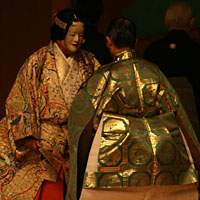Dear Alice,
A new noh theater has opened at the Takeda Shrine here in Kofu, and I went to see the first performance, a play called "Makiginu." The actor who played the role of the priestess wore a very beautiful costume. Seen from the front, it was extremely elegant. But when viewed from behind ooh la la! You have never seen such an unsightly bottom. The seat of the pants was so stiff and wide it could almost be used as a bench chair, yet the character never sat down! So what the heck is the significance of this?
Annie S., Kofu, Yamanashi Prefecture
Dear Annie,
Boy, did you ever ask the wrong person I know nothing about noh. In fact, I was so intimidated by the topic that I let your question ripen in my inbox for some time. When I finally worked up the courage to approach it, not only did I find you an answer, but I also learned that this ancient art, the very oldest form of Japanese theater, is far more accessible than I had thought.
I took your question over to the National Noh Theatre in Tokyo, where I got a gracious reception from curator Yukie Kadowaki. By the way, while the usual word in Japanese for theatrical costumes is isho, used in both modern productions and kabuki, there's a special word for the costumes in noh. It's shozoku, written with the kanji for "clothing" and "promise." Noh costumes are flamboyant and elaborate, including some of the most beautiful kimono ever created. The broad-in-the-beam vestment that caught your attention is hakama, the tie-on trousers that are a part of traditional Japanese formal wear for men and, in some cases, women. This specific type is called oguchi-bakama, the first part meaning "wide-legged," and the second being "hakama." ("Ha" becomes "ba" when it's put in a compound word). The "bench in the bum" look, created by sewing stiff matting into the seat, is a sign of status: the bigger the clothing, the higher the social standing.
Kadowaki explained that noh was developed for the nobility in ancient Japan, and as such, the costumes are modeled after the clothing worn by aristocrats of the time, for whom unwieldy clothing was visible proof of their status, a way of telling the world they were so exalted that they didn't have to do anything that actually required movement. Actually, the wide-legged hakama you saw on stage is a relatively modern concession, developed some time during the 15th or 16th century, which makes it at least a little easier to walk. The old style, which you can still see in some noh plays and the occasional historical drama on TV, were so long that you had to tread on the inside of the trouser legs as you walked, the foot never emerging and the ends of the trouser legs flapping and trailing behind.
One of the interesting things I learned on my visit is that the costumes worn on a noh stage don't belong to the theater but to the individual actors, or their ryuha (school of noh). Many noh actors were born into families that have performed noh for generations, and the costumes and masks have been passed down from father to son. (Traditionally, only men performed noh, but there are now some female noh actors.) The oldest noh costume still in use belongs to the Kanze school in Kyoto, and it is said to be more than 500 years old. It's not exactly in prime condition anymore, but the school's tradition holds that it was a gift from the eighth shogun, Ashikaga Yoshimasa (1435-1490), and is therefore too precious to retire.
Noh is performed around the country in venues ranging from dedicated theaters to outdoor stages, but the main centers for noh are Tokyo, Osaka and Kyoto. If you've never seen noh, a good place to start is the National Noh Theatre in Tokyo because it offers interpretation in both English and modern Japanese. Last fall the theater equipped all seats with a personal screen displaying explanations and dialogue. You can turn the screen off if you prefer to watch the performance without interpretation, and you can't see what's on the screen for the seat next to you.
I asked Youji Moronuki, a producer at the theater, for some advice for noh novices. Although viewers will get more out of a performance if they study up a bit in advance, learning the story line and a few basics about noh, he stressed that it is possible to enjoy a noh performance without any preparation, particularly if you see a show with interpretation. Moronuki suggested viewing a noh performance first and foremost as a musical, focusing on the music, dance and song. "And enjoy the gorgeous costumes," he urged, "because the visual spectacle of the costumes is part of what makes noh noh." Before I left, I pressed my sources for tips on understanding noh costume, little hints for the would-be "in the noh" bum-watchers among my readers. While the rules on costume are not as rigid as you might think for a tradition-bound art such as noh, they did allow that if an actor is wearing the wide-bottomed oguchi-bakama, you can be pretty sure his character is of relatively high status. If the hakama are red, the character is a young woman. Visitors from the world of spirits, including gods and ghosts, tend to wear white or light blue hakama, while the really gorgeous, patterned hakama are generally reserved for warrior and monster roles.
For information in English about performances at the National Noh Theatre, and noh in general, go to www.ntj.jac.go.jp/english/index.html. If you and your children understand Japanese, there are special family performances Aug. 10-11, with easy-to-understand explanations and opportunities to try out the instruments used in noh. You can reserve tickets in English by calling the National Noh Theatre Ticket Centre at (0570) 07-9900 or (03) 3230-3000.



